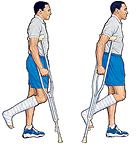Discharge Instructions: Using Crutches (Non-Weight-Bearing)
Discharge Instructions: Using Crutches (Non–Weight-Bearing)
Your healthcare provider has prescribed crutches for you. A healthy leg can support your body weight, but when you have an injured leg or foot, you need to keep weight off it. The “swing to” method of walking, sometimes called gait, is easy to learn and takes less arm strength and balance. The “swing through” gait takes more practice, but it moves you farther with each step and is less tiring overall. Start with “swing to” and progress to “swing through” when instructed.
Before you use crutches
Be prepared:
Remove throw rugs, electrical cords, and anything else that may cause you to fall.
Arrange your household to keep the items you need handy. Keep everything else out of the way.
Find a backpack, fanny pack, or apron, or use pockets to carry things. This will help you keep your hands free.
Standing with crutches
Use the balanced standing (tripod) position when you start or end a movement. Also use it whenever you’re standing for a length of time.
Move your crutches in front of you about 12 inches.
Hold the injured (or weaker) foot off the floor.
Find your balance.
Be sure not to rest your armpits on the pads of the crutches.
Walking with crutches
Tips include the following:
Start in a balanced standing (tripod) position.
Squeeze the crutch pads against the sides of your chest.
The bottom tips of the crutches should be wide enough apart for you to move easily between them.
Support your weight on your hands, not on your armpits.
Swing to gait
With your crutches in front of you, press down on the handgrips.
Lift your good (stronger) foot and swing your body up to the crutches.
Land on your good foot, between your crutches.
Keep the knee of your injured or weaker foot slightly bent.
Reach forward and out with the crutches to begin the next step.
Swing through gait
With your crutches in front of you, press down on the handgrips.
Lift your good (stronger) foot and swing your body through the crutches.
Land on your good foot, about 12 inches in front of the crutches.
Keep the knee of your injured leg slightly bent.
Reach forward and out with the crutches to begin the next step.
Follow-up
Make a follow-up appointment as directed by your healthcare provider.
When to call your healthcare provider
Call your healthcare provider right away if you have any of the following:
Sudden or increased shortness of breath
Sudden chest pain
Fever above 100.4°F (38.0°C)
Increasing redness, tenderness, or swelling at the incision site or in the injured limb
Drainage from the incision or injured limb
Opening of the incision or injury
Localized chest pain with coughing
Updated:
August 14, 2018
Sources:
Overview of Geriatric Rehabilitation: Program Components and Settings for Rehabilitation. UpToDate
Reviewed By:
Image reviewed by StayWell art team.,Joseph, Thomas N., MD,Moloney Johns, Amanda, PA-C, MPAS, BBA

